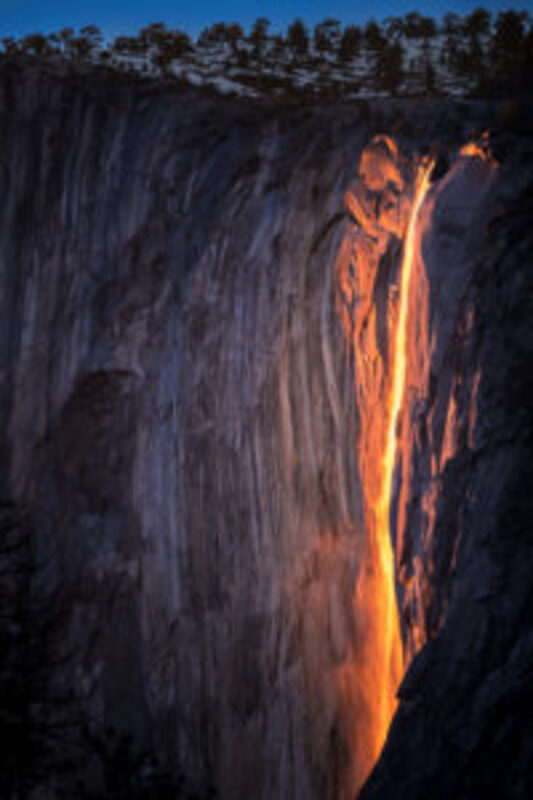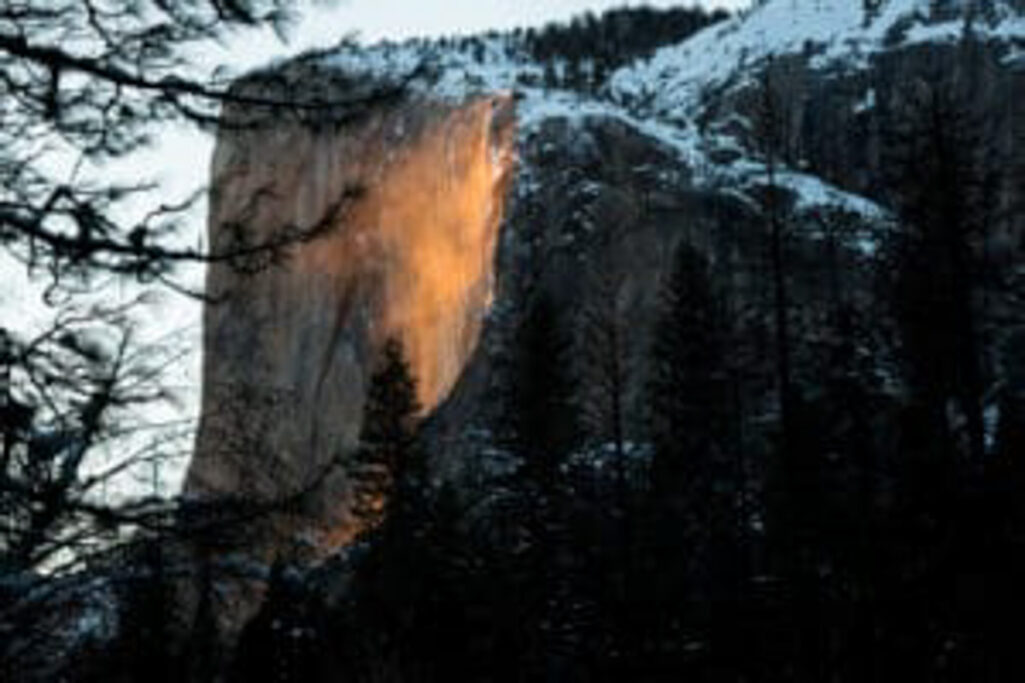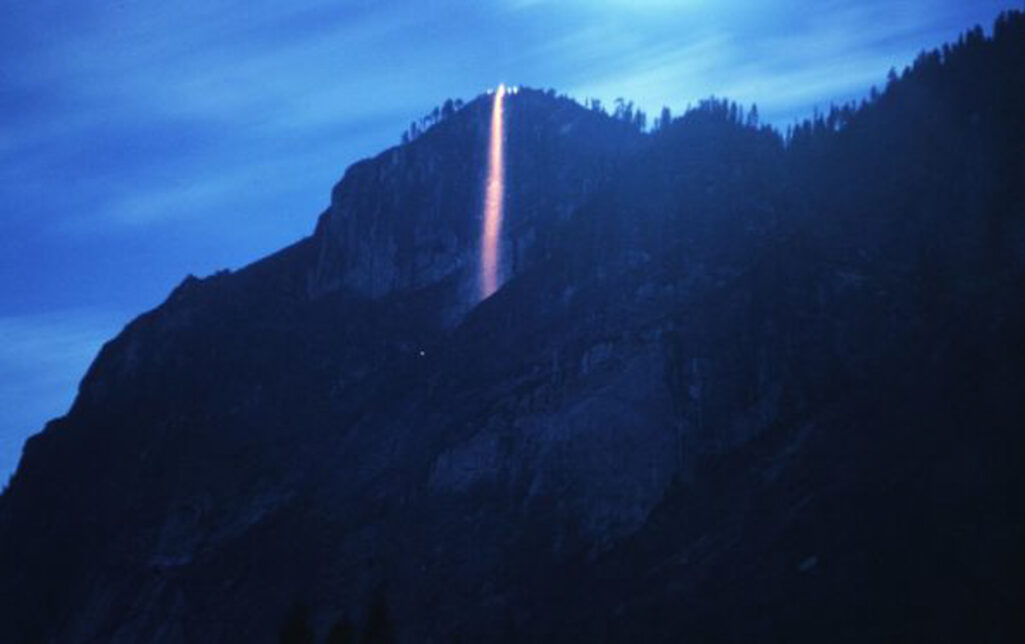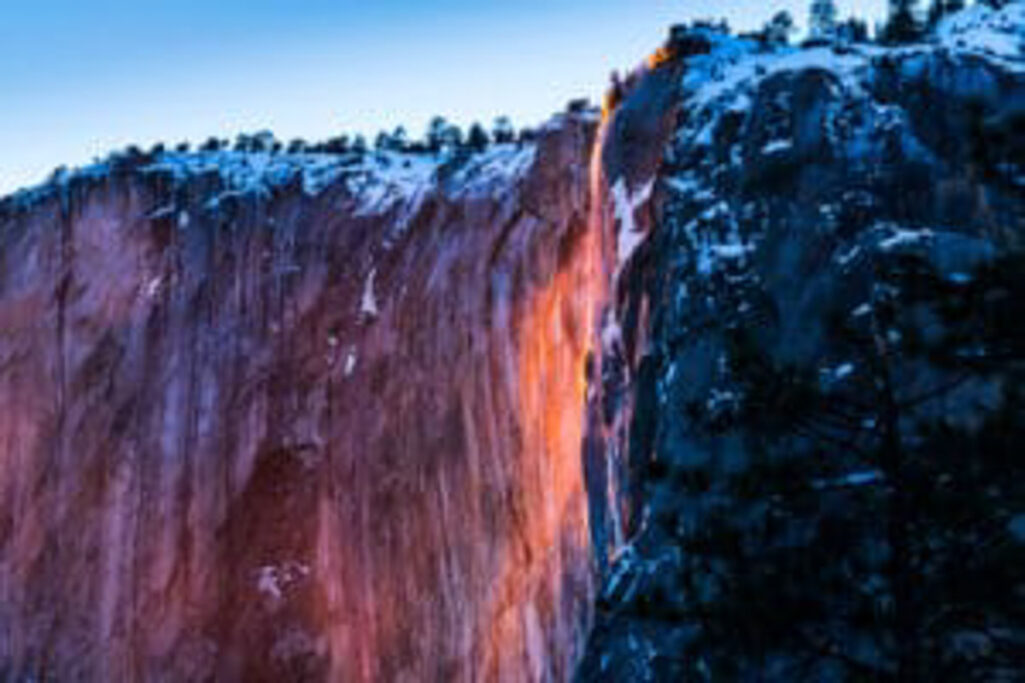What the Heck is a “Firefall?”
…And How Do I See Yosemite’s?
Demystifying the fleeting orange glow of Horsetail Fall in late-February, and shedding light on the story’s strange origin
On odd nights during the tail-half of February, when conditions align just right, Horsetail Fall sets itself on fire.
Sheets of snowmelt wisp into the abyss to summon the last rays of the dying day, and a natural phenomenon roars to life. These aberrant evenings, when conditions are just right, a sliver of El Capitan stretches out to catch the sun and casts its reflection through the fleeting plumes of Horsetail Fall, setting it aglow in one of earth’s most majestic and elusive light shows.
It’s as real as any view in Yosemite, but it’s not actually a fall of fire. In fact it’s quite the contrary. But from a western vantage in the valley without context, it’s near impossible to ignore the resemblance its glowing curtains bear to another, less phenomenal fall of fire.
Behold: a unicorn of natural phenomena, and the jackpot on every scenic photographer’s bucket list.

How Do I See The Firefall For Myself?
It may be a long, wintery wait if your goal is to snap a selfie with Horsetail Fall in all its illuminated glory.
Every winter between mid- and late-February, hoards of tourist and photographers flock to the meadows below El Cap hoping to for the chance, but the fickle performance is known to turn crowds away disappointed.
Several conditions must synchronize to ignite the cascade. Chief among them—water must be flowing, which requires ample snowpack to feed its headwaters, and warm enough daytime temps to melt the snow so it flows into night. Next, the sky west of El Cap, as well as the air in the valley, must be perfectly clear.
A single cloud separating El Cap from the sun can smother the effect, and even a slight haze can dramatically dampen the display.
When these factors do align—the downing sun graces the horizon at just the right angle and El Cap wraps its eastern wall in a hulking, half-mile-high shadow, water billows full-bore from the Valley’s rim with not a visible blemish of vapor in the air, anyone in sight of El Cap’s eastern face can behold a precious view of mother nature’s serene magic trick. The show lasts for around 10 minutes, then disappears with the sun.
If you’re still dead-set on seeing the Horsetail Firefall in person, we have a few tips that will better your odds.
First, start monitoring snowpack levels in early winter, and get serious if snow is plentiful atop El Cap in late-January. Keep tabs on local river flow rates, and compare with previous years to determine the likelihood of seasonal fall activity. Monitoring the live webcam for Yos Falls is another great way to gauge conditions. If thing’s look promising by late-January, schedule a week off at minimum and make arrangements to visit Yosemite between Valentines Day and March 1—the window during which the Firefall is most likely to occur. According to Aaron Meyers a veteran Yosemite photographer who posts a calculated prediction for the best date/time to view the Firefall each year,
the best bet seeing it in 2020 is on February 22, if all conditions are met.
Pack plenty of warm layers, but cross your fingers for clear, warm-ish weather during your stay. When you arrive, find the most unique viewpoint you can find, pat yourself on the back for placing yourself in that space and time, set up your tripod/camera and keep your trigger finger on high-alert while you watch, wait and revel in one of the most stunning landscapes on earth.
Feel free to give us a ring along the way! We’ll have the inside scoop on the Firefall’s status, and we offer single-day tours that feature the Firefall among other seasonal waterfalls.

But wait…if memory serves you right, you recall a friend once telling you with genuine conviction that the Firefall is a real cascade of fire! In fact, you’re pretty sure a few people have said so, and what’s worse, you bought that bull!
Don’t beat your buddy up just yet.
Yes, the most popular Firefall in Yosemite history was made with actual fire. That’s right—Yosemite has hosted more than one firefall in its lifetime!
The true Firefall, and historically the most poplar, first erupted in 1872 on the Valley’s south rim, when a shower of glowing embers unexpectedly leapt from Glacier Point, through the summer night’s sky, and into a basin of granite boulders partway up the slab wall adjacent to Curry Village. The event was less a natural marvel, more a gimmick to lure in visitors. While it achieved the originator’s desired effect of garnering attention from the budding tourist community below, as it were, the achievement was entirely inadvertent.
The accidental birth of Yosemite’s “original” firefall can be indirectly attributed to Glacier Point’s primitive transportation infrastructure at the time.
(author’s note: the Glacier Point fall is still credited as the “original,” despite the painfully anti-LNT and entitled essence of the manmade attraction and the discovery that Horsetail Fall’s existed for countless centuries prior.) Glacier Point Road wouldn’t be finished for another 50 years, and even the wagon trail that proceeded it was a decade down the line.
Thus the beloved viewpoint could be reached only after hiking up the only approach—a grueling mule path that started beneath Sentinel Rock and gained 3,200 feet of elevation over fewer than five switchbacking miles before finally depositing travelers at the top.
That trail, now dubbed “4-mile Trail” (oddly enough, given that it’s really more of a 5-mile trail), remains one of the most strenuous treks out of Yosemite Valley today.
History confirms that logic and physical improbability are no match for the ambitious whims of capitalism, and James McCauley, the proprietor of Glacier Point’s earliest hotel had no intention of challenging that sentiment. Eager to commandeer customers from the bustling hotels in the Valley below, he predicted an onslaught of tourists would flock up the footpath like his hotel was the Field of Dreams. He opened the establishment, unconcerned with the access issues, and low and behold, business was bad from the start.
Undiscouraged, McCauley devised a surefire solution: He’d host a party at the Mountain House Hotel, and light a giant bonfire on the tip Glacier Point to draw in the crowd.
Hours into his big night, McCauley’s event was offensively attended. Eventually he snapped, frustrated that the only guests present were his three sons. In a fit of frustration, he commanded that his sons put out the fire by shoving it off the cliff into the rock pile below. His boys obliged, pushing the embers into open air above the tourists-occupied hotels below. To McCauley’s pleasant surprise, the spectacle was a hit!
Sensing a business opportunity in the onlookers’ applause, the next day McCauley ordered his boys down to the Valley to collect funds for another firefall. People paid up, even the owners of competing hotels, who welcomed the novel source of entertainment for their guests. McCauley’s hotel never gained the impressive guest list he initially sought, but his novel fire show soon became a nightly event that more than made up for the shortcomings of his hotel. The nightly Firefall from Glacier point continued uninterrupted for 25 years thereafter, until McCauley was evicted in 1897.

After a hiatus of several years, the Firefall ceremony at Glacier Point was rekindled by another hotel owner—David Curry (of Curry Village)—and the proverbial torch was passed on through various private enterprises throughout the 20th century. No longer a nightly event, the Glacier Point Firefall tradition continued sporadically until the last fire ever to be pushed off the point fell on January 25, 1968, when the National Parks Service banned the practice once and for all in light of mounting environmental concerns.
Ready for the kicker? Six months later an electrical fire sparked on the ground floor of the Glacier Point Hotel, and the entire estate—including McCauley’s Mountain House—fell to the ground in flames.
Conveniently enough, snowfall had collapsed a large section of the roof during the previous winter, prompting reparations that found the hotel closed and vacant at the time of the fire.
Five years later, in February 1973, a photographer named Galen Rowell captured the first known image of a “Natural Firefall” on El Cap, exposing a “new,” natural firefall for park businesses to tout.
While it had been happening all along, its popular hay-day only came, if ironically, when the manmade edition was permanently extinguished. Even still, the stories continue to get mixed together in dinner table yarns, contributing even more mystique and silliness to the legend of Yosemite’s Firefall.
Author’s note: The great firefalls of El Cap and Glacier Point are not to be confused with the great Firefall of Rush Creek Lodge, which is neither fire nor fall, but a delicious rendition of the piña colada sold during summers. As of 2024, it is now a resort on Highway 120 as well! I guess capitalist exploits are just part of the history.

MORE
Take A Backpacking Trip to Half Dome
Featured Day Hike: Tour Yosemite’s southern rim from Glacier Point to Mist Trail
Summer Camp: Our 6-day Yosemite High Country Adventure

